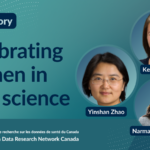HDRN Canada celebrates the contributions of women in advancing multi-regional health data research


On the tenth anniversary of International Day of Women and Girls in Science, HDRN Canada is celebrating the contributions that women make to our mission of bringing people together for transformative and world-leading health data use. The United Nations adopted the day of observance in 2015 to recognize the critical role that women and girls play in science, technology, engineering and mathematics (STEM) and to strengthen their participation. Across HDRN Canada’s pan-Canadian network of member organizations, women take leading roles to advance our collective work in data science within the context of multi-regional health data research.
“I’ve always been drawn to how mathematical concepts could be applied to uncover patterns and insights, and this curiosity evolved into an interest in data science,” said Narmada Retnakaran, Associate Director, Repository at the Manitoba Centre for Health Policy (MCHP). With a background in computer science, Retnakaran oversees the management, expansion, maintenance and access for MCHP’s data repository, a collection of administrative, registry and survey data relating to residents of Manitoba. In her work, understanding patterns in data can lead to better diagnoses, personalized treatments and more effective solutions to global challenges, and multi-regional health research amplifies that impact.
Multi-regional health research enables comparison of routinely gathered administrative data from more than one province or territory across the country to examine health trends among diverse populations. “This diversity is critical to identifying health disparities and tracking disease prevalence,” Retnakaran explained. “Data can often be messy, incomplete or biased, which means significant time is spent cleaning and preparing it to be analyzed. Despite these challenges, the rewards of working with multi-regional data to solve problems and make informed decisions are incredibly fulfilling.”
For Kendra Lester, a love of math and an interest in health care led her to a career in epidemiology, a field she’d never heard of until she finished her undergraduate degree. “I saw a conference presentation about the Electronic Medical Record in Newfoundland and Labrador, and I knew immediately that was where I wanted to work.” Now the Senior Director of Provincial Data and Information Services at Newfoundland and Labrador Health Services, she leads a team of over 60 people with a mission of making high quality data available to decision makers and researchers.
The best part about Lester’s job? “Bringing together data from multiple sources to answer important questions, monitor trends and inform decision and policy making,” she said. Because administrative data are collected in the context of providing health care, and not necessarily with analysis in mind, it can create challenges when her team doesn’t have access to the data necessary to meet the specific information needs of internal and external stakeholders. “This encourages us to think outside the box to determine what we may be able to access instead, or how we need to adjust our methods to account for any problems with data availability.”
Yinshan Zhao was drawn to data science for the way it combines critical thinking, problem solving and working with diverse people. “There are many rewarding aspects of working as a data scientist, but one that stands out for me is the opportunity to solve problems creatively,” said Zhao, a Senior Data Scientist who supports data intake, linkage and provisioning at Population Data BC and engages in multiple sclerosis research. “Whether it’s applying existing methods to novel problems or developing new methodologies to tackle unique challenges, it keeps the work dynamic and stimulating.”
Zhao contributes to HDRN Canada’s efforts in harmonizing data and developing algorithms that can be applied across multiple jurisdictions. She underscored the importance of multi-regional research for increasing the number of individuals included in a study, yielding more robust results. “Recent studies using data from multiple regions have helped create a better picture of how people with multiple sclerosis interact with the health care system in the phase of the disease before classic symptoms appear. This shows that multi-regional research using administrative health data can give us a broader and more diverse perspective, reshaping our understanding of a disease.”
Retnakaran, Lester and Zhao are shining examples of the progress women have made in STEM. But with a global average of only 33.3 percent of women researchers in STEM, it’s clear that more work needs to be done to reduce the gender gap at all levels of these disciplines. Retnakaran encourages young women and girls with an interest in science to stay curious and cultivate a love for learning. “Keep pushing boundaries, and remember that your unique perspective is an integral part of shaping a more inclusive, innovative world,” she said. Zhao believes that building domain knowledge—knowledge of a specific area—is critical for success as a data scientist and recommends participating in conferences, seminars and forums to develop and share that specialized knowledge. Lester emphasized the importance of finding a good mentor, while offering a reminder that not everyone’s journey will look the same. “Don’t compare yourself to others along the way,” she said. “Work hard, trust your gut, and don’t be afraid to step outside of your comfort zone.”
